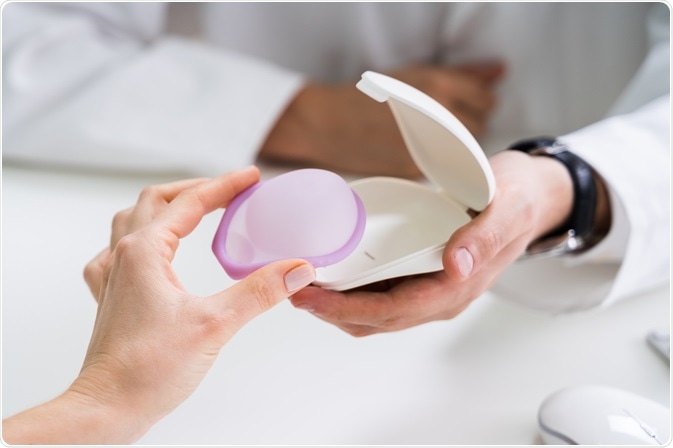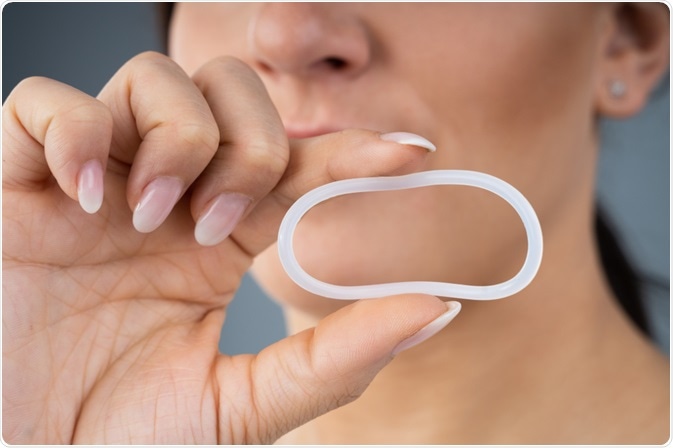There are several different female contraceptive devices that can be directly inserted into the woman's vagina, which includes a diaphragm, a vaginal cap, or a vaginal ring.

Image Credit: Natty_Blissful / Shutterstock.com
Types of contraceptive devices
A contraceptive diaphragm is a reversible non-hormonal method of barrier contraception that prevents fertilization by not allowing the entry of sperms into the uterine cavity through the cervix.
A diaphragm is a cup-shaped soft silicone device that is designed to be fitted over the cervix through the vagina before sexual intercourse. This covers the external opening of the cervix and obstructs the passage of sperm. A diaphragm is always used with a spermicide to kill any sperms which come into contact with its upper surface, which is in contact with the cervix.
A vaginal ring is a soft ring containing estrogen and progestogen, which is intended to deliver a low steady concentration of these hormones into the bloodstream. It is therefore a means of hormonal contraception. The vaginal ring acts by rendering the cervical mucus unfavorable to sperm passage, preventing ovulation, and hindering the normal endometrial thickening which prepares the uterus for implantation of a fertilized oocyte.
Insertion of the diaphragm

Image Credit: Andrey_Popov / Shutterstock.com
The vaginal diaphragm is meant to be inserted into the vagina up to three hours before any act of vaginal intercourse. Spermicide should be put inside the concave side and also smeared liberally over the convex surface. It should be left in place for at least six hours afterward, but never more than 30 hours in all, to prevent the risk of infection.
The diaphragm is then removed and washed carefully, dried in the air, and stored in a clean dry container until its next use.
The woman should be instructed to use only mild and fragrance-free soap to wash their diaphragm. No other oil-based products or perfumes, or talcum powder, is to be used. Furthermore, the diaphragm should never be boiled. It is also wise to check for obvious damage to the diaphragm before using it.
There are different sizes of the diaphragm; therefore, it is important to attend a contraceptive clinic for the first fitting. A doctor or nurse will help the woman find the right size of the diaphragm and learn how to insert it without assistance.
Various postures may be adopted for inserting the diaphragm, depending on which is comfortable and expands the vaginal opening sufficiently. Squatting, lying down, or putting one foot up on a chair in the erect position, are all suitable.
After putting some spermicidal cream on both sides of the diaphragm and its rim with clean hands, the diaphragm should be squeezed between the thumb and fingers to fold it in half, with the top of the cup facing downwards.
The diaphragm is then slid gently into the vagina until it reaches the cervix. At this point, one finger is used to push up the anterior rim of the diaphragm high in front of the cervix, over the pubic bone anteriorly.
The position should be checked at this point. The cervix should be felt as a firm but yielding mass through the diaphragm. If you feel the cervix outside the diaphragm, remove the device and repeat the procedure. The woman should check that the diaphragm stays in place when she walks around, squats, sits, or coughs.
Some clinics offer a temporary diaphragm for practicing insertion and for testing if the woman feels comfortable with its use. This does not provide contraception; therefore, backup methods should be used during this time. The woman is instructed to insert and wear the practice device before attending the follow-up appointment so that the healthcare provider can ensure it fits properly and the woman has familiarized herself with the technique.
The diaphragm size may have to be changed after a year, if the woman gains more than 3 kilograms, or after any pregnancy, due to a change in the shape and size of the vagina. When used postpartum, the diaphragm should be fitted after six weeks. The diaphragm should not be used during menstruation.
The currently produced diaphragm is self-fitted and is suitable for all sizes of women. It can achieve a success rate of 86% if used properly.
Insertion of a vaginal cap
The vaginal cap is a small silicone device with a folded rim, which is fitted over the cervix, similar to a diaphragm, to prevent sperm entry into the uterine cavity. It is smaller than the diaphragm and comes in three sizes. The insertion technique is identical to that used for the diaphragm.
A vaginal cap should be used only with spermicide. Vaginal caps are more effective in nulliparas; however, some women find that fits the vagina better than the diaphragm does. A vaginal cap can be worn for up to 72 hours during each use.
Insertion of a vaginal ring
The vaginal ring is a small, soft silicone ring that is about 4 millimeters (mm) thick, with a diameter of 5.5 centimeters (cm). A vaginal ring is to be worn for 21 days and then discarded.

Image Credit: Andrey_Popov / Shutterstock.com
The insertion procedure is simple, as follows:
- One ring is removed from the foil packaging, which is saved for later disposal.
- The woman may use a sitting, lying, squatting, or standing position with one foot elevated, to open the vagina slightly.
- The ring is gently squeezed transversely and inserted as far up into the vagina as is comfortable and will hold it in position.
The vaginal ring can be removed by just hooking the rim with one finger and pulling it out. It should be disposed of only in the waste bin, not in the toilet.
References
Further Reading